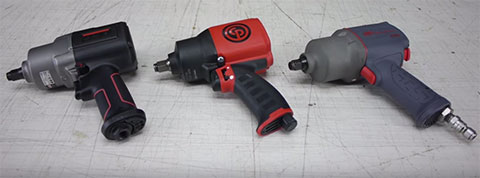One of the biggest questions we always get with pneumatic tools, or any tools for that matter, which one is more powerful? When it comes to air tools there are several different numbers you will see on the boxes and it’s clear manufacturers are not using any sort of standardization to report these numbers. Torque is also affected by application, air pressure and other environmental conditions so getting an exact number is not always easy. All 3 of these impact wrenches are their respective brands top dogs, composite construction and have been launched within the last year. (**3/15/16 – We also added new testing for 1/2″ Cordless Impacts vs Air Impacts)
Working Torque: The range of torque to be used on a daily basis both in forward/reverse. For instance your average full-size pickup lug nut should be put on about 120-180 ft. lbs. and may require much more to take it off depending on how & when it was put on. This should give a range which you would get from switching the tool from the lowest setting to highest. Jet JAT-121 ($229) reports a 50-550 ft-lbs, CP7749 ($229) goes from 100-522 ft-lbs., IR 2235TiMAX ($279) does not report a “working torque” range only max torque 930 ft-lbs. and “Nut Busting Torque”.
Max Torque, Break Away or Nut Busting Torque: “Let’s settle this once and for all: in most cases, advertised “ultimate” or “bolt break away” torque is really just a marketing ploy. Manufacturers will test tools in ways that allow them to increase the advertised torque rating, but these methods do not yield an accurate portrayal of real or “working” torque. Sure, you may be able to get 1000 ft-lbs of torque here and there, but this is often not the genuine working torque that the tool is readily capable of day to day.” (Quoted directly from Ingersoll website)
This should refer to max power in reverse, logically the highest torque a tool can produce to break a nut free. Ingersoll reports a 930 ft-lbs max torque but also 1350 ft-lbs Nut Busting Torque. The Chicago Pneumatic “Max Torque” is 955 ft-lbs while the Jet R12 “Max Torque” is 750 ft-lbs. Neither Jet nor CP give any additional Break Away or Nut Busting figures.
Torque Testing: We just tested max forward torque here which is the easiest, most accurate way to compare these impacts to one another. We are not measuring max reverse or “nut busting torque” because it would be significantly more involved to do accurately and correctly. We added oil and ran each tool a little first, then did 3 test runs to build the maximum bolt tension on the 1-1/4” Skidmore. As you can see in the video the needle bounces a bit so there is a small degree of estimation here of about 2-3% either way.
Testing Results: Tool weight came in with the Ingersoll as heaviest at 4.65 lbs, Jet at 4.2 lbs and the CP lightest at only 4.05 lbs. The torque results we found were as follows: Jet R12 JAT-121 35,000 bolt tension / 525-550 ft-lbs, Chicago Pneumatic CP7749 40,000 bolt tension / 600-625 ft-lbs and finally IR 2235TiMAX 45,000 bolt tension / 675-700 ft-lbs. These rankings were in line with how these 3 should compare to one another but also a very good example of how differently the 3 brands give their numbers. The Jet seemed to be right in line with the high end of the “working torque” range. The CP “working torque” was actually below our results they give. Finally the IR did not give a “work torque” so it was hard to line up with the other two, this also means there are no given numbers of power you might expect out of that lower power settings, is it 50 ft-lbs, 100 ft-lbs, 150 ft-lbs?
This torque testing has only made us less confident we could rely on numbers from other impacts like AirCat, Snap-On, Mac or others might compare using what they printed on their boxes. Of these 3 Ingersoll Rand clearly had the most power but we are planning a 1/2″ cordless impact test to follow in the near future so stay tuned!
*NOTE ON TESTING ACCURACY – This Skidmore (1-1/4″) was calibrated within the last 6 months and our focus is on the relationship between the different tools and consistency. For all our torque testing we use an 8 second count to build pressure so the time is consistent across each tool’s testing. If we allowed the tools to build pressure until they could no longer “move the needle” we are confident we would see higher torque numbers, which is no doubt what each manufacturer does when posting their higher stats. This isn’t wrong, however adds to the confusion of “working torque vs max torque”. For our comparison testing however we feel this is less accurate, as 1 tool might build pressure 12 seconds, another tool 18 seconds and comparison testing overall would less accurate. In the real world 8 seconds for a single bolt is actually a long time, if you’re don’t believe us just ask any bull rider.
This is just a simple torque test and we are not looking at how these tools might perform over the long haul. If you have any questions on which ½” air impact wrench might be best for your needs and budget give the pros at Ohio Power Tool a call 800-242-4424.



It is really a great and useful piece of info. I am glad that you shared this helpful information with us. Please keep us up to date like this. Thank you for sharing.